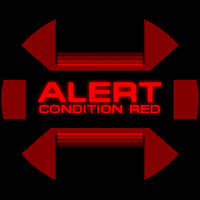| Number
|
Name
|
Description
|
| 0
|
Condition Green
|
- Cancels all alert statuses and conditions.
- Sets all decks to normal operations.
|
| 1
|
Tactical Alert
Red Alert
General Quarters
Battle Stations
|
- Defensive status signaling that a crew needs to be ready for combat.
- All nonessential personnel are to move to shelter areas.
- Damage control teams deployed to emergency locations.
- All combat stations to be fully crewed.
- Charge / arm all weapons.
- Raise shields at full power.
- Automatic diagnostics on primary and secondary systems.
- Secure and seal off critical areas.
- Security personnel deploy to defensive positions.
- Command personnel report to stations.
- Standard lighting reduced / control surface lighting increased.
- All relevant preparations from Yellow Alert / Condition 3.
|
| 2
|
Temporal Alert
Condition Blue
|
|
| 3
|
Yellow Alert
|
- Charge defensive systems.
- Damage control teams ready to deploy.
- Security teams report to security office for deployment assignments.
- Department heads report to stations.
- Standby crews report to stations.
- Secure communications.
- Reduce power to non-essential systems.
|
| 4
|
Environmental Alert
|
- Damage control teams deploy to standby locations.
- Security teams deploy to evacuation locations.
- Medical teams deploy to standby locations.
- Seal all decks at critical cross-sections.
- Seal all decks from adjacent decks.
- Seal all external doors and access points.
- Seal jefferies tubes at all junctions.
- Set each decks environmental controls to independent operation.
- All non-essential personnel report to shelter areas.
|
| 5
|
Decompression Alert
Collision Alert
|
- All relevant procedures of Environmental Alert.
- Damage control teams deploy to critical areas.
- Medical teams deploy to shelter areas.
- Seal all isolation doors on all decks.
- Erect emergency force fields around critical areas.
- Inertial dampeners to full power.
- Structural integrity field to full power.
- Command and control areas isolated to independent power.
- Evacuate outermost areas.
|
| 6
|
Security Alert
|
- Security officers issued phaser rifles and body armor.
- Security teams deploy to critical areas.
- Post guards in critical areas.
- Post guards at turbolifts, access points to adjacent decks, and transporter rooms.
- Flag officers, commanding officer, along with 2nd and 3rd in command are given armed escorts.
- Damage control teams assigned to assist security at discretion of Operations Officer.
- Commanding Officer reports to the bridge / operations and localizes command functions to the bridge and main engineering.
- Chief Engineer reports to main engineering ready to assume control of systems if other areas are compromised.
- Security Chief organizes search teams and patrol teams.
- Non-essential personnel return to quarters.
- Secure all communication lines.
- Restrict computer access to Level 1 and above.
- Shut down transporters.
- Seal all external hatches and doors.
- Seal all decks from adjacent decks.
- Seal all access to jefferies tubes.
- Tactical officer begins intensive continuous sensor sweeps of surrounding area.
- Operations Officer begins continuous internal sensor scans and reports all anomalous signals to chief of security.
- Department heads secure their areas and account for all personnel.
|
| 6A
|
Security Readiness
Heightened Security
|
- Security officers issued Phaser Rifles and body armor.
- Security teams deploy to critical areas.
- Post guards in critical areas.
- Post guards at turbolifts, access points to adjacent decks, and transporter rooms.
- Flag officers, commanding officer, along with 2nd and 3rd in command are encouraged to accept armed escorts.
- Security Chief organizes additional patrol teams.
- Secure all communication lines.
- Restrict computer access to Level 1 and above.
- Seal all external hatches and doors.
- Seal all decks from adjacent decks.
- Seal all access to jefferies tubes.
|
| 7
|
Grey Mode
|
- All non-essential systems powered down.
- Non-essential areas evacuated, including crew quarters, to shelter areas and powered down.
- Primary and secondary systems reduced to minimum power.
- Sensors to passive mode to reduce computer processing load.
- Reduce computer power to minimal levels.
- Replicators and transporters shut down.
- Propulsion systems set to minimal power output and shut down when not in use.
- Power generation systems put on load rotation to reduce fuel consumption.
|
| 8
|
Medical Quarantine
|
- All transporters and shuttle bays are shut down.
- Shields are raised.
- Quarantine beacons are activated warning vessels away from the station.
- Solas Tempus HQ at Tranquility is informed of the emergency.
- Security places at points of egress.
- No personnel on the station are allowed to leave.
- Medical staff to determine other required measures.
|
| 9
|
Stealth Mode
|
- Protocols for Conditions 1 and 6A are executed.
- Power output brought to 2% of normal to minimize energy signature.
- Cloaking / Phasing Cloaking systems are engaged if present.
- No transmissions of any kind without command approval.
- Sensors switch to passive mode only.
- Deploy TEUFEL probes if possible and set to autonomous sensor swarm.
- Take additional concealment measures are necessary and possible.
|
| Theta
|
Theta Protocol
|
|
